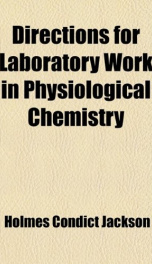directions for laboratory work in physiological chemistry

Purchase of this book includes free trial access to www.million-books.com where you can read more than a million books for free. This is an OCR edition with typos. Excerpt from book: SIMPLE PROTEIDS. 11 5. To 5 c.c. of this solution add (NH4)2 SO4 (salt) to saturation. Note results and see if the precipitation is complete in each case. (a) Acidify 10 c.c. of the albumin solution with HCl. 1. To 5 c.c. of this solution add 2 drops of phosphotung- stic acid. 2. To 5 c.c. of this solution add 2 drops of potassium- mercuric-iodide. (e) To successive portions of 5 c.c. of the albumin solution add a few drops of CuSO4; neutral and basic lead acetate; HgCl2; trichloracetic acid. Make careful notes of the results of the above reactions, and where possible write equations. SIMPLE PROTEIDS. Albumins. (?) Coagulation. Heat 5 c.c. of the albumin solution and then add one or two drops of acetic acid. The albumin separates out in an insoluble, flocky (coagulated) form. Why is the addition of the acetic acid necessary? Try to dissolve the coagulum in some of the ordinary proteid solvents. Make 5 c.c. of the albumin solution faintly alkaline, and heat. Note differences. (?) To 10 c.c. of the albumin solution add (NH4)2SO4 to saturation. Note result and compare with experiment (c) 5, p. 11. Filter off the precipitate and test the filtrate with the .Biuret test. (c) To 10 c.c. of the albumin solution add MgSO4 to saturation. Compare this result with that of experiment (c) 4,p. 11. Now add 2 drops of acetic acid. What is the precipitate? (d) Test the albumin solution for loosely combined sulphur. (e) Warm some dried albumin in a dry test-tube to about 100 C. Then try to dissolve it in water. Why does not the albumin coagulate by the heat? Globulins. (a) Try two proteid color reactions and three precipitation reactions; see if the solution will coagulate. (b) Globulins are insoluble in water but dissolve in weak salt soluti...
Info about the book
Author:
Series:
Unknown
ASIN:
B004IP0QM0
Rating:
3/5 (5)Your rating:
0/5
Languge:
English
Users who have this book
Users who want this book
What readers are saying
What do you think? Write your own comment on this book!
write a commentif you like directions for laboratory work in physiological chemistry try:
Other books by this author
Do you want to exchange books? It’s EASY!
Get registered and find other users who want to give their favourite books to good hands!

